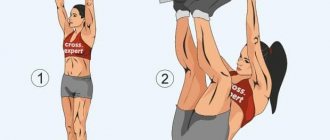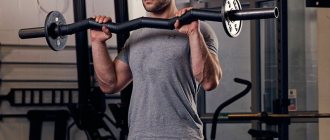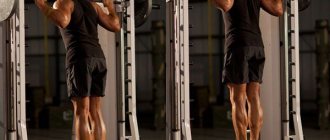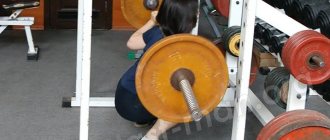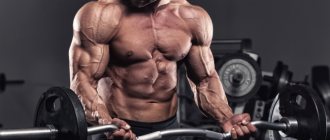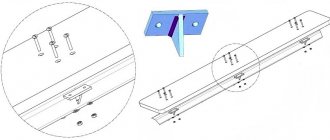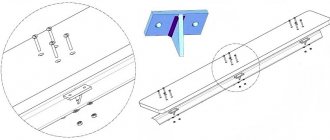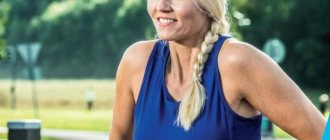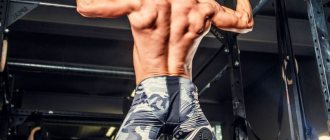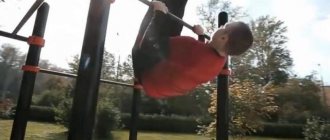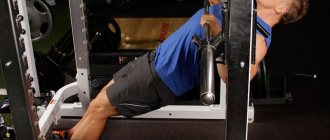Kip-up technique. Swing forward and send the legs, swinging is performed on the forward swing, the legs are brought to the bar, the lift ends on the back swing. Then the main extension occurs, the legs are brought forward upward, while the arms are straight and the pelvis is pressed against the pole, by pressing with straight arms on the pole and moving the legs after moving back, the movement of the legs back helps to raise the shoulders.
Sequence of training: swinging bends on the forward swing, bringing the legs to the crossbar and bringing them forward upward; on the wall, from a standing position, lowering through straight arms and legs and lifting back by pressing the hands; performing exercises with help, performing independently. Insurance and assistance, standing on the side, one hand under the thigh, the other under the lower back.
Mistakes: not bringing the legs to the pole sufficiently and throwing the legs too high, throwing the legs after bringing them up, not pressing the pelvis, bending the arms.
Kip-up from an arm support: with a forward swing, the gymnast must lift the body as high as possible, followed by extension in the hip joints to a bent-over support position on the arms. Next, straighten up, sending your legs forward and up, stopping the movements of your legs, press with your straight arms on the poles and move to a point-blank range, completing the backswing. The sequence of training: from the shoulder blade stand with your hands on the floor, transition to a position lying on your back, bent over, with the last transition to a sitting position; from the emphasis on the hands, bent over, lifting into an extension to the support, legs apart with the help and independently, performing the exercise with the help and independently. Insurance and assistance: standing on the side, supporting with one hand under the shoulder blades, the other under the pelvis.
66. Swinging bends on the bar.
Execution technique.
from the hang, shoulders down, raise your legs, bending at the hip joint, without bending your arms. Then, lowering the legs and straightening the hip joint, the back swing occurs. During the back swing, the lower back and shoulder joints work actively and rigidly. On the backswing you need to pull your shoulders back. The span must be amplitude.
Teaching methodology.
1.imitation of swinging movements while standing on the floor.
2.From hanging on the bar, swing with a small amplitude with the help of a teacher.
3.do it yourself
Insurance and assistance are carried out from the student’s side, one hand between the shoulder blades and the other on the hips.
Main mistakes: bending the arms, lack of coordination in movements, when moving the legs back, the shoulders are stiff and not pulled back, the lower back is relaxed.
Lifting with a kip from a hanging position, and from an emphasis on the hands, bent over.
Kip-up technique. Swing forward and send the legs, swinging is performed on the forward swing, the legs are brought to the bar, the lift ends on the back swing. Then the main extension occurs, the legs are brought forward upward, while the arms are straight and the pelvis is pressed against the pole, by pressing with straight arms on the pole and moving the legs after moving back, the movement of the legs back helps to raise the shoulders.
Sequence of training: swinging bends on the forward swing, bringing the legs to the crossbar and bringing them forward upward; on the wall, from a standing position, lowering through straight arms and legs and lifting back by pressing the hands; performing exercises with help, performing independently. Insurance and assistance, standing on the side, one hand under the thigh, the other under the lower back.
Mistakes: not bringing the legs to the pole sufficiently and throwing the legs too high, throwing the legs after bringing them up, not pressing the pelvis, bending the arms.
Kip-up from an arm support: with a forward swing, the gymnast must lift the body as high as possible, followed by extension in the hip joints to a bent-over support position on the arms. Next, straighten up, sending your legs forward and up, stopping the movements of your legs, press with your straight arms on the poles and move to a point-blank range, completing the backswing. The sequence of training: from the shoulder blade stand with your hands on the floor, transition to a position lying on your back, bent over, with the last transition to a sitting position; from the emphasis on the hands, bent over, lifting into an extension to the support, legs apart with the help and independently, performing the exercise with the help and independently. Insurance and assistance: standing on the side, supporting with one hand under the shoulder blades, the other under the pelvis.
Swinging bends on the bar.
Execution technique. from the hang, shoulders down, raise your legs, bending at the hip joint, without bending your arms. Then, lowering the legs and straightening the hip joint, the back swing occurs. During the back swing, the lower back and shoulder joints work actively and rigidly. On the backswing you need to pull your shoulders back. The span must be amplitude.
Teaching methodology.
1.imitation of swinging movements while standing on the floor.
2.From hanging on the bar, swing with a small amplitude with the help of a teacher.
3.do it yourself
Insurance and assistance are carried out from the student’s side, one hand between the shoulder blades and the other on the hips.
Main mistakes: bending the arms, lack of coordination in movements, when moving the legs back, the shoulders are stiff and not pulled back, the lower back is relaxed.
Features of classes with women.
At the mature age of 29-34 years, the main tasks are: development and perfection of physical qualities (strength of the abdominal muscles, back, muscles surrounding the hip joint), flexibility (spine, hip joints), plasticity, endurance, speed; increasing and strengthening emotional stability; nurturing perseverance, courage, determination, activity; promoting the harmonious development of organs and functions; formation of posture; preservation or formation of a harmonious physique; stress relief. The means are: outdoor sports in all forms, with increased intensity, exercises in artistic gymnastics, rhythmic gymnastics, stretching, yoga, fitness, aerobics, calanetics. It is necessary to dose the load and monitor your pulse. The maximum heart rate is calculated at 220-age, but you cannot always work at this heart rate. In the first period of training, the pulse should be 40-60% of the maximum. At the age of 35-55 years, the main task of training is to maintain health and performance, and resist the aging process.
41.characteristics of educational and developmental types of gyms. This group of gyms includes: basic, athletic, women's, professional applied, sports and applied and military applied. Basic gymnastics has great opportunities for solving health, educational and educational problems. Objectives: formation of harmonious physical and spiritual development of the individual, formation of necessary skills and abilities, increasing the arsenal of knowledge, development of physical. And moral qualities. Means: outdoor gear in pairs, with and without objects, with varying intensities, acrobatic elements, jumping, hanging exercises and stops. Basic gymnastics is included in the education system of school and preschool institutions.
Women's gymnastics takes into account the characteristics of the body and psychological make-up of women. The classes include all types of outdoor exercise equipment: freestyle exercises without apparatus and with apparatuses, exercises on the anthem wall, bench, etc. In classes with women, artistic gymnastics exercises, elements of ballroom and folk dances occupy a large place
. Special attention is paid to musical accompaniment of classes. With the help of these exercises, coordination of movements, flexibility, grace, and beauty of movements are developed, correct posture is formed, health is improved, and physical and mental performance increases. Gymnastics with a professional orientation combines exercises and methodological techniques with the help of which it is possible in a timely manner, before the start of vocational training, to increase the functional capabilities of the body, and those qualities that are needed for the chosen type of profession. Control complexes are composed depending on the type of profession. Basic means: outdoor switchgear, varieties of walking and running, elements of acrobatics. Athletic gymnastics is a means and method for developing muscle strength, strength endurance and will, and the functional capabilities of the body; introducing teenagers and young men to systematic physical exercise; formation of healthy lifestyle; preparing boys for work, and girls for childbearing and motherhood.
Applied sports gymnastics is aimed at the general and special physical training of an athlete, the development of his physical qualities, and the improvement of individual movements that are included in the sports motor actions he is studying. The content of applied gymnastics is specified depending on the type of sport in which the athlete is improving.
51.composition of the panel of judges. The panel of judges includes: the chief judge, senior judges, secretaries, competition judges, informant judges, screening committee, doctor, timekeeper, and event judges.
The chief judge checks the readiness of all technical documentation, equipment, inventory, sets the time for drawing lots, testing equipment, and draws up a competition schedule. Appoints judges for individual events, remove a participant, cancel the competition.
Deputy chief judges - 1 - organization of competition and material and technical support; 2 - management of judicial teams. Chief Secretary and Secretariat. The chief secretary checks applications, prepares protocols, forms the composition of the secretariat, and prepares a report on the competition. The senior judge manages the work of the judging panel at the event, monitors order at the event, calls participants, evaluates the exercise, keeps a working protocol, issues an assessment, and does not allow participants and trainers dressed inappropriately to compete.
The judges at the participants line up the participants before leaving, supervise the moving part, and monitor discipline. Line judges in free exercises are located on opposite corners of one diagonal and fix the athlete's step on the line. Judges in the event evaluate the execution of the exercise,
57. Features of classes with women.
At the mature age of 29-34 years, the main tasks are: development and perfection of physical qualities (strength of the abdominal muscles, back, muscles surrounding the hip joint), flexibility (spine, hip joints), plasticity, endurance, speed; increasing and strengthening emotional stability; nurturing perseverance, courage, determination, activity; promoting the harmonious development of organs and functions; formation of posture; preservation or formation of a harmonious physique; stress relief. The means are: outdoor sports in all forms, with increased intensity, exercises in artistic gymnastics, rhythmic gymnastics, stretching, yoga, fitness, aerobics, calanetics. It is necessary to dose the load and monitor your pulse. The maximum heart rate is calculated at 220-age, but you cannot always work at this heart rate. In the first period of training, the pulse should be 40-60% of the maximum. At the age of 35-55 years, the main task of training is to maintain health and performance, and resist the aging process.
41.characteristics of educational and developmental types of gyms.
This group of gyms includes: basic, athletic, women's, professional applied, sports and applied and military applied.
Basic gymnastics
has great potential for solving health, educational and educational problems. Objectives: formation of harmonious physical and spiritual development of the individual, formation of necessary skills and abilities, increasing the arsenal of knowledge, development of physical. And moral qualities. Means: outdoor gear in pairs, with and without objects, with varying intensities, acrobatic elements, jumping, hanging exercises and stops. Basic gymnastics is included in the education system of school and preschool institutions.
Women's gymnastics
takes into account the characteristics of the body and psychological make-up of women. The classes include all types of outdoor exercise equipment: freestyle exercises without apparatus and with apparatuses, exercises on the anthem wall, bench, etc. In classes with women, artistic gymnastics exercises, elements of ballroom and folk dances occupy a large place
Special attention is paid to musical accompaniment of classes. With the help of these exercises, coordination of movements, flexibility, grace, and beauty of movements are developed, correct posture is formed, health is improved, and physical and mental performance increases. Gymnastics with a professional orientation
combines exercises and methodological techniques with the help of which it is possible in a timely manner, before the start of vocational training, to increase the functional capabilities of the body, and those qualities that are needed for the chosen type of profession. Control complexes are composed depending on the type of profession.
Basic means: outdoor switchgear, varieties of walking and running, elements of acrobatics. Athletic gymnastics
is a means and method for developing muscle strength, strength endurance and will, and the functional capabilities of the body; introducing teenagers and young men to systematic physical exercise; formation of healthy lifestyle; preparing boys for work, and girls for childbearing and motherhood.
Applied sports gymnastics is aimed at the general and special physical training of an athlete, the development of his physical qualities, and the improvement of individual movements that are included in the sports motor actions he is studying. The content of applied gymnastics is specified depending on the type of sport in which the athlete is improving.
51.composition of the panel of judges.
The panel of judges includes: the chief judge, senior judges, secretaries, competition judges, informant judges, screening committee, doctor, timekeeper, and event judges.
The chief judge checks the readiness of all technical documentation, equipment, inventory, sets the time for drawing lots, testing equipment, and draws up a competition schedule. Appoints judges for individual events, removes a participant, cancels competitions.
Deputy chief judges - 1 - organization of competition and material and technical support; 2 - management of judicial teams. Chief Secretary and Secretariat. The chief secretary checks applications, prepares protocols, forms the composition of the secretariat, and prepares a report on the competition. The senior judge manages the work of the judging panel at the event, monitors order at the event, calls participants, evaluates the exercise, keeps a working protocol, issues an assessment, and does not allow participants and trainers dressed inappropriately to compete.
The judges at the participants line up the participants before leaving, supervise the moving part, and monitor discipline. Line judges in free exercises are located on opposite corners of one diagonal and fix the athlete's step on the line. Judges in the event evaluate the execution of the exercise,
This article is suitable for those people who are interested in workout or are just at least a little interested in it. I would like to start with a warning that you should not try to repeat the kip-up if you have not had any physical training before. This warning is not empty words. Health is the foundation for our subsequent achievements, so it must be protected. If you are going to learn how to do kip-ups, then it is best to start with long-term, but high-quality physical training. And after that, you can start learning and show off your new skills on the street to your acquaintances and friends. We wish you a pleasant reading of this article and good luck learning the kip-up!
Features and Benefits
Riveting or lifting with an extension on a horizontal bar is a strength exercise that belongs to the category of yard gymnastics or workout techniques. When performing, the main emphasis is on working with your own weight, as well as on the rhythm of movements and systematic training. With the right approach, the athlete develops endurance and develops clear muscle boundaries. Thanks to exercises on the horizontal bar, girls relieve tension, improve posture, and make their breasts more toned.
With the right approach, the horizontal bar allows you to neutralize the consequences of sedentary work and pump up your abdominals, back, and arms. Thanks to the exercises, the flexibility of the spine increases, creating the basis for subsequent mastery of more complex elements and techniques.
The muscles that are most affected when performing a rivet are:
- toothed;
- biceps;
- deltoid;
- trapezoidal;
- large round;
- triceps;
- brachioradialis;
- latissimus dorsi muscles.
The rivet can have not only positive, but also negative effects on the body. Ignoring the rules for organizing training or failing to comply with breathing patterns can lead to injury. But the greatest risk is for people who have contraindications to performing exercises on the horizontal bar.
Conditions and diseases in which you should not exercise on the horizontal bar without the supervision of a specialist:
- heart pathologies;
- respiratory diseases;
- stones in the kidneys;
- herniated discs;
- instability of the cervical vertebra;
- rachiocampsis;
- post-operative or post-traumatic recovery.
The last point refers to temporary contraindications. As soon as the rehabilitation comes to an end and the attending physician allows physical activity, you can start doing pull-ups on the horizontal bar.
Where to begin?
Before you think about how to do a kip-up, you should learn how to do a bridge. Learn to bridge from your back and do bridge push-ups. Some consider this point optional and begin to study the kip-up without any stretching. But not all people are able to do this exercise, without acquiring the skill of bridge push-ups and other things. You must understand how you should arch correctly in the kip-up movement. Therefore, in order to avoid unnecessary injuries, troubles, and generally simplify your life, start with this.
The meaning of the name and the first of the leading exercises
First, think about the name of what you are going to study. “Kip-up”, that is, your body should straighten, rise due to kip-up alone. You need to learn how to set the impulse of movement with an extension.
The first lead-in exercise is the kip itself. You need to learn how to do it in amplitude. To do this, lie on the floor on your shoulder blades and, raising your legs up, sharply rest them on the ground, starting a little. When you begin to feel that your body has completely mastered this movement and is ready to move forward, this means that you can move on to the next leading exercise .
The second lead-up exercise is where you continue the previous movement. This is still the same extension with a bend in the back, pushing off the ground and landing on your haunches. For a more successful push from the ground, you can rest your hands on the ground and help yourself push off a little.
Execution technique
The exercise includes several elements. Here's how to properly make a rivet on a horizontal bar:
- Vis. The legs are parallel to the ground, the grip is straight and narrow (arms are spaced narrower than shoulder width). The reverse option, in which the palms are turned inward, is difficult for beginners.
- Rocking. This is nothing more than a deviation of the body back and forth with a gradual increase in angle. The amplitude increases due to alternate work of the legs and shoulder muscles. At this stage, rhythm is very important; jerking should be avoided.
- Leg lift. You need to reach your toes towards the bar. The release is done at the peak, at the moment when the body is at the highest point.
- Kip-up. It is accomplished due to inertia. The athlete straightens up, as a result of which he rushes upward under his own weight. There is an emphasis on both hands, and then a return to the starting position.
There is a version of the exercise with a deflection in the lumbar area. With this type of execution, at the second stage of riveting, the body swings due to arching of the torso, and not due to the purposeful throwing of the legs. The deflection is done when the body moves forward. The most protruding part in the starting position is the chest, the legs are only directed in the desired direction.
Third lead-in exercise. Real kip-up
The third lead-up exercise is actually the same kip-up. “Kip-up” is the English name for a kip-up. Push your entire body as far as possible with your arms and try to land on your feet as best as possible while remaining fully erect. Now all you have to do is practice and practice this exercise so that someday you will be able to do a clean and correct kip-up. For some, it was easier to learn to do this exercise while on a slightly inclined, rough surface. But do not forget that everything here is actually quite individual. For some, it is necessary to learn how to do push-ups in a bridge, while others need this same tilt. Based on your own feelings and try to harm yourself as little as possible.
And that's probably all. Good luck with your further training and happy kipping!
"Bryansk State School (Technical School) of the Olympic Reserve"
METHODOLOGY FOR INITIAL TEACHING SWING GYMNASTIC EXERCISES ON THE BAR
TUTORIAL
on the course "Gymnastics"
Bryansk 2011
Methodology for initial training in swing gymnastic exercises on the horizontal bar. Textbook for the course “Gymnastics” / FGBOU SPO “BSUOR”. – Bryansk, 2011. – 10 p.
The textbook sets out methodological recommendations that provide practical guidance on the initial training of swing gymnastic exercises for students of the Bryansk State School (technical school) of the Olympic reserve who do not specialize in artistic gymnastics. Methodological recommendations can be used by students in their independent preparation and in the process of educational practice.
Reviewed and approved at a meeting of the Methodological Council of the FSBEI SPO "BSUOR"
Protocol No.
©FGBOU SPO "BSUOR", 2011
| Introduction……………………………………………………………………………… |
| 1. A brief dictionary of the most common terms on the crossbar ……………………………………………………………… |
| 2. Methodology for teaching swinging bends……………………….. |
| 3. Method of teaching swinging pull-ups………………… |
| 4. Methodology for teaching swinging from a jump……………………… |
| 5. Methodology for teaching kip-ups on a low bar…… |
Introduction.
The work program for the discipline “Basic and new types of physical culture and sports activities with the methodology of health training (gymnastics)” for training students in specialties 050141 “physical culture”, 050142 “adaptive physical culture” for students of the pedagogical department of BSUOR provides for training on the horizontal bar in the following elements : swinging, hanging turns with a forward swing, swinging with another one of the supports, jumping with a swing forward and backward (bending), lifting with a kip on a low bar. Mastering all these elements is only possible if students are able to swing with a large amplitude. There are no special developments in teaching aids for mastering swinging. It is supposed to consist of simple movements and therefore does not require special training. However, practice shows that most students who do not specialize in gymnastics are not prepared either physically or technically to perform swinging. In accordance with the noted shortcomings, the proposed methodological recommendations provide introductory exercises that ensure the appropriate level of physical development of students and their mastery of the technique of performing swinging gymnastic exercises based on swinging.
1. A brief dictionary of the most common terms on the crossbar.
Vis
- a position for those exercising on the apparatus in which their shoulders are below the grip points. While hanging, the gymnast is held on the apparatus, being attracted to it.
Hanging while standing
- the position of the student in which he is in a stand and holds on to the apparatus, slightly deviating from the vertical, but no more than 45 degrees.
Hanging lying down
- a hang in which the student, holding the apparatus with his hands and resting his feet on the floor, forms an angle with the supporting plane of less than 45 degrees.
Max
- a movement of the gymnast in one direction, performed near grip points (hanging), or some parts of the body relative to others (standing).
According to the direction of movement there are:
Swing forward
- movement of the gymnast from the extreme point in the back to the extreme point in the front, performed with the chest forward.
Swing back
- the same movement, but from the extreme point in front to the extreme point in the back, performed towards the back.
The main methods of swinging are as follows.
Waving
- a series of swing movements following one after another.
Swinging curves
- free movement of the legs and torso forward and backward, during which the gymnast bends and extends at the hip joints (Fig. 1)
Swinging pull-up
- performed by bending the arms while simultaneously lifting the legs with a jerk-like movement of the body forward and upward.
Swinging from a jump
- swinging performed after a hanging jump, followed by a hanging pull-up while the gymnast’s body moves backward.
The swing is different
- a swing arc-shaped movement of the gymnast, in which his legs and body describe the largest possible trajectory (along an arc)
Kip-up
- a lift performed by a gymnast by straightening the body at the hip joints.
The following kip-ups are performed on the low bar:
From the jump
- with this lift, the legs immediately after the jump are brought to the crossbar.
From a jump to a hanging angle
- after the jump, a forward movement is made while hanging at an angle, and only then the legs are brought to the crossbar.
Turn-
movement of the body around a vertical axis regardless of the position of the gymnast.
2.Methodology for teaching swinging bends.
Task:
learn to swing with a large amplitude.
Sequence of movements:
from hanging on a high bar, raise your legs forward and swing them freely back;
On the forward swing, successively bring your legs and torso closer to the crossbar and pull forward. Possible mistakes:
1. The backward swing of the legs is not performed freely, but tensely.
2. The body does not rise to the bar on the bars.
3. At the end of the forward swing, bend.
Lead-in exercises:
1. Hanging angle (hold for 20 seconds)
2. From hanging while standing on a low bar, swing one and push the other, lifting with a flip at point-blank range (up to 9 times)
3. From hanging while standing on a low crossbar, jump into point-blank range and jump off another (10-20 times)
Execution of swinging:
It is conditionally divided into two steps.
1. From hanging on a high bar, raise your legs to a horizontal level and freely swing your legs back to a bent position (2-3 sets of 5-7 times).
2. Swinging bends is performed in general (5-7 times).
Methodological notes.
1. Particular attention is paid to the high swing of the legs and torso forward to the crossbar and pulling it forward.
2. To avoid stalling at the end of the backswing, it is recommended to change the position of the hands on the forward swing.
After mastering swinging bends, you can move on to the following exercises:
Another swing from point-blank range.
This exercise is first performed on a low bar, a medium bar and then a high bar (5-10 times each).
3. Method of teaching swinging pull-ups.
Task:
learn to swing with a large amplitude using pull-ups.
Sequence of movements:
Pull yourself up with the simultaneous movement of your legs forward and, bringing your legs and torso closer to the crossbar in sequence, pull forward with your whole body.
Possible mistakes:
1. Arms are not bent enough.
2. The body does not rise forward with a forward swing.
3. At the end of the forward swing, there is not complete retraction in the shoulder joints and straightening in the elbow joints.
Lead-in exercises:
1. From hanging on a high bar, pull-ups (at least 10 times)
2. From hanging on a high bar, rise by turning over to point-blank range (5-10 times)
Performing a pull-up swing:
1. From hanging on a high bar, the exercise is performed as a whole with the help of a partner (3-7 times).
2. The exercise is performed as a whole without outside help (7-10 times).
Methodological notes.
Particular attention is paid to raising the legs, the torso forward and then pulling the whole body into a hanging position with straight arms.
Doing other exercises.
I. From swinging while hanging on a high bar with a forward swing, turn into hanging with a different grip.
The exercise is performed completely from the beginning with the help of a partner (5-7 times) at a small amplitude (3-5 times), and then at a large amplitude (7-10 times)
4. Methods of teaching swinging from a jump.
Task:
learn how to swing from a jump.
Sequence of movements:
From a short run-up or from one step, jump into a hanging position on the crossbar with the simultaneous movement of your legs forward and, successively bringing them closer to the body to the crossbar, pull forward and upward with your whole body.
Possible mistakes:
The same as with other methods of waving. In addition, specific ones are also possible, for example, after a pounce there is no forward swing.
Lead-in exercises:
Perform the exercise on the middle bar (5-7 times) with an emphasis on moving the body forward after jumping into the hanging position.
Performing a hanging swing from a jump:
1. The exercise is performed with the help of a partner (5-7 times).
2. The exercise is performed without outside help (5-10 times).
Doing other exercises.
After mastering swinging while hanging from a jump, it is advisable to move on to performing dismounts:
1. Back swing (5-7 times).
2. Swing forward (10-12 times).
5. Methodology for teaching kip-ups on a low bar.
Task:
Learn to perform a kip-up on a low bar.
Sequence of movements:
From hanging while standing on a low bar, immediately after the jump, sharply bring your toes to the bar, make an extension movement with a short movement, raise your shoulders and torso up and forward, and come out point blank.
Possible mistakes:
1. Legs slowly rise forward.
2. Legs do not rise enough to the bar.
3. Arms bend
4. There is no retraction in the shoulder joints while hanging while standing.
Lead-in exercises:
From hanging while standing on a low bar, perform bending and bending movements without lifting your toes off the mat. This exercise involves moving your torso while keeping your legs in a constant position (10-20 times).
Methodological notes:
When performing the approach exercise, one strives to leave the legs in one place on the mat and move the body forward and backward as freely as possible, with an emphasis on strongly bending forward and pulling at the shoulder joints.
Performing a kip-up on a low bar:
1. Perform a lead-in exercise and, while moving your torso forward, sharply bring your legs to the crossbar; perform a kip-up with the help of a partner (10-15 times).
2. Perform a kip-up with a jump (10-15 times).
3. Perform a kip-up from a jump to a hanging angle (5-7 times).
1. Artistic gymnastics: a textbook for institutes of physical culture (under the general editorship of Yu. K. Gaverdovsky and).-M.: Physical culture and sport, 1979.-309 pp., ill.
2. Gymnastics: textbook. for students higher textbook establishments / , . – 4th ed., revised – M.: publishing house, 2006. – 448 p.
3. Gymnastics: textbook / , . – Rostov n/a: Phoenix, 200 pp.- (Higher education).
When you watch films about kung fu and see all these tricks, you understand: professional acrobats are acting in the frame. Nevertheless, every physically developed and moderately flexible person can repeat the kip-up. Moreover: this is not just a spectacular movement, it is an exercise that trains explosive strength.
To lift yourself off the floor, you will need a strong shoulder girdle and lower body (with fast-twitch muscle fibers ideally loaded). And then in the blink of an eye to land on your feet in the desired position, you will need coordination of all movements. Once you learn how to do a kip-up, you’ll appreciate the results both on the tennis court and in hand-to-hand combat.
How to learn quickly
Proper preparation and the right horizontal bar are designed to make the path to sporting achievements easier. The latter should be low. If a person, standing on the ground, can reach the crossbar, then the choice of projectile is successful.
The recommended preliminary exercises for beginner athletes are:
- aerobic exercise (for example, jumping rope);
- activation of joints (swings, rotations);
- exercise with an expander;
- dumbbell row with left and right hands;
- stretching the muscles involved when working with the bar.
If the effectiveness of training does not increase over time, then in addition to warming up, it is worth working out each element of the rivet separately.
| Element | Nuances |
| Rocking or Swinging | When the body leans forward, the legs extend as much as possible in the direction of movement. The shoulder girdle works in the opposite direction. During swinging, the muscles relax. |
| Leg Raising | While hanging, you need to learn how to lift your legs at the same time. |
| Repulsion | Parallel swinging and throwing the legs forward with a concomitant upward movement of the shoulders and an attempt to raise the pelvis to the level of the horizontal bar. |
Warm-up
To do a good kip-up, you first need to do a proper warm-up! Namely, stretch the necessary muscles. In acrobatics, stretching is key, along with coordination and speed. In order for everything to work out effectively and beautifully, you need to progress well enough in all three areas.
It is necessary to stretch the fold; it will allow you to make a good amplitude swing of the legs. Sit on the floor, stretch your legs forward, clasp your feet with your hands and stretch your body forward and down.
Do the “birch tree” exercise. It will allow you to understand where your impulse to “jump” comes from.
Stretch your lumbar region. Good stretching will allow you to move with greater range of motion and land on your feet easier. Lie on the floor on your stomach, place your palms on the floor and stretch back.
Stretch your shoulders and lower back, this will allow you to push yourself well and get back to your feet. Do the bridge exercise.
Learning to do kip-up
To begin mastering the kip-up, perform introduction exercises that will allow you to understand how to lift your body off the floor with the help of a leg swing and some arm effort. Also, try to understand the smallest details of the exercises, they will come in handy. To do this you will need two mats.
2.1. Jump from a crease position
A fold is a sitting position: leaning forward, you need to touch your straight knees with your chest. In our exercise, the fold will be upside down. This exercise will help you learn to lift your body off the floor.
Push yourself out by swinging your legs and helping yourself with your arms.
2.2. Jump from the shoulder blades to the bridge
Once you have succeeded in jumping out of the crease, you can move on to the next lead-in exercise, which will allow you to achieve a good extension of the body.
Lie on your back on the mat, with your palms near your head and your straight legs pressed to your body. - By swinging your legs, pull your heels towards your back.
Get up on the bridge.
Common mistakes and useful tips
To fully understand the principles of the horizontal bar riveting technique, it is important to find out what problems beginner athletes face. Possible reasons for failure:
- failure to warm up (a body unprepared for loads is unable to react correctly to the rivet, hence dislocations, falls, sprains);
- breathing problems (long delays, intermittency due to jerky movements disrupt breathing, as a result of which the body begins to receive less oxygen; you should breathe according to the standard pattern: ascent - inhale, descent - exhale);
- untimely raising of legs - premature or late;
- lack of rhythm, impetuosity of movements (each jerk takes an unacceptable amount of strength and causes an imbalanced load on the muscles);
- incorrectly selected horizontal bar (you should start from a low one);
- weakness of the preparatory push of the legs to perform the exercise;
- full straightening of the elbows (the exercise eliminates this position while lowering the body);
- shifting the emphasis from the arms and back muscles to the legs (ideally, lifting is carried out only by the upper extremities, and the lower ones do not participate in the process);
- muscle weakness.
Correct execution requires not only knowledge of the technique, but also minimal physical training. If a person has studied the theory, but is not able to not only pull himself up, but simply hang for a while, then he will not be able to perform a pull-up on the horizontal bar. Difficulties can also arise due to a complete misunderstanding of your body. Doing a bridge will help you learn about the characteristics and capabilities of your body. After mastering the exercise, you should move on to push-ups from the indicated position.
Riveting is an exercise that hones strength skills and flexibility. To perform correctly, it will require studying the principles, minimal physical preparation and pre-warming. By following these rules, the benefits of training are significantly increased and possible risks are reduced.
To avoid dislocations, falls or sprains, you should definitely warm up before performing the rivet. A common mistake for beginners is untimely raising of the legs (premature or late)
Ideally, lifting the body is carried out only by the upper limbs, but the legs do not participate in the process
We carry out kip-up
First, practice doing the element on two mats. Firstly, it will be softer for you to land, and secondly, they will cushion you a little and it will be easier for you to do a kip-up. Then remove one mat and practice some more.
Lie on your back on the mat, with your palms near your head and your straight legs pressed to your body.
- Get to your feet.
Voila! You did it! Now remove the mats completely and do a kip-up on the floor.
Important!
If you are afraid of landing painfully, then try to slide along a trajectory opposite to the movement, i.e. first lower your heel, then your hip, pelvis and lower back.
Kip-up from somersault
This exercise is not fundamentally different from the kip-up, but there are some features of performing a somersault. Practice on the mat first.
When you enter a somersault, control your center of gravity; it should be as far behind you as possible. — Perform an incomplete somersault, that is, move only part of your body forward and lie on your shoulder blades.
Swing your straight legs as high as possible, while pulling your heels towards the back of your head and maintaining tension in your lower back. - Get to your feet.
Basic mistakes
1. Insufficiently powerful leg swing. This mistake will prevent you from getting off the floor.
The swing should be strong and powerful, it should be performed with straight legs, while the deflection in the lower back should be ensured by good tension in it.
2. Swing with bent legs. You can do the exercise this way, but it doesn’t look pretty. The swing must be strong and powerful and must be performed with straight legs.
3. Insufficient push with hands. For beginners, the hands-free kip-up option is not suitable - it will be quite difficult to complete. You can try not pushing with your arms if you can actually swing your legs well and lift yourself up with just your legs.
4. Tense abs during landing. Such a mistake leads to the fact that you land on your haunches, and then get up from your haunches. It's not beautiful. When landing, you should be in a camber. Only due to this the element will look beautiful and put you on level feet.
Today you have mastered the kip-up exercise and how it can be performed from a somersault. We sorted out the main mistakes and understood what is good and what is bad in the kip-up.
Step by step lesson instructions
1. Do a good warm-up, paying special attention to the crease, lumbar region and shoulders.
2. Practice jumping out of the crease position on the mats using a strong leg swing. 3. Practice jumping from a position lying on your shoulder blades into a bridge by swinging your legs and pushing your hands onto the mat. 4. Try doing a kip-up. Lie on your back, fix your palms near your head, press your straight legs to your body, lift yourself with straight leg swings as high as possible, while pulling your heels towards the back of your head and maintaining tension in your lower back. 5. Combine a regular forward roll with the kip-up you just mastered. 6. Practice on the mats first, then try to do the element on the floor. If you are afraid of landing painfully, then try to slide along a trajectory opposite to the movement.
And in the next lesson, Max Rusanov will introduce you to the cool “forward somersault” element. See you soon;) !
Music used in the video: Major Lazer – “Get free”.
